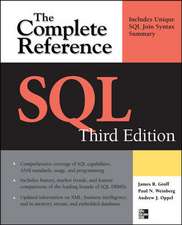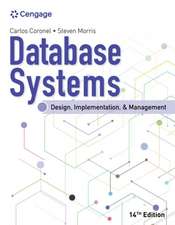Data Modeling, A Beginner's Guide
Autor Andy Oppelen Limba Engleză Paperback – 16 feb 2010
Publisher's Note: Products purchased from Third Party sellers are not guaranteed by the publisher for quality, authenticity, or access to any online entitlements included with the product.
Essential Skills--Made Easy!
Learn how to create data models that allow complex data to be analyzed, manipulated, extracted, and reported upon accurately. Data Modeling: A Beginner's Guide teaches you techniques for gathering business requirements and using them to produce conceptual, logical, and physical database designs. You'll get details on Unified Modeling Language (UML), normalization, incorporating business rules, handling temporal data, and analytical database design. The methods presented in this fast-paced tutorial are applicable to any database management system, regardless of vendor.Designed for Easy Learning
- Key Skills & Concepts--Chapter-opening lists of specific skills covered in the chapter
- Ask the expert--Q&A sections filled with bonus information and helpful tips
- Try This--Hands-on exercises that show you how to apply your skills
- Notes--Extra information related to the topic being covered
- Self Tests--Chapter-ending quizzes to test your knowledge
Preț: 252.53 lei
Preț vechi: 315.66 lei
-20% Nou
Puncte Express: 379
Preț estimativ în valută:
48.32€ • 51.67$ • 40.29£
48.32€ • 51.67$ • 40.29£
Carte disponibilă
Livrare economică 27 martie-10 aprilie
Preluare comenzi: 021 569.72.76
Specificații
ISBN-13: 9780071623988
ISBN-10: 0071623981
Pagini: 368
Dimensiuni: 188 x 234 x 22 mm
Greutate: 0.6 kg
Editura: McGraw Hill Education
Colecția McGraw-Hill
Locul publicării:United States
ISBN-10: 0071623981
Pagini: 368
Dimensiuni: 188 x 234 x 22 mm
Greutate: 0.6 kg
Editura: McGraw Hill Education
Colecția McGraw-Hill
Locul publicării:United States
Cuprins
Part I: Data Modeling Concepts; Chapter 1. Introduction to Data Modeling; Chapter 2. Relational Database Components; Chapter 3. Data and Process Modeling; Chapter 4. Organizing Database Project Work; Part II: Data Modeling Details; Chapter 5. Conceptual Data Modeling; Chapter 6. Logical Database Design Using Normalization; Chapter 7. Beyond Third Normal Form; Chapter 8. Physical Database Design; Part III: Design Alternatives; Chapter 9. Alternatives for Incorporating Business Rules; Chapter 10. Alternatives for Handling Temporal Data; Chapter 11. Modeling for Analytical Databases; Chapter 12. Enterprise Data Modeling; Part IV: Appendixes; Appendix A. Answers to Self Tests; Appendix B. Solutions to Try This Exercises; Index























